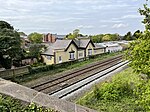Huxley, Cheshire
Cheshire West and ChesterCheshire geography stubsFormer civil parishes in CheshireVillages in Cheshire

Huxley is a small rural village and former civil parish, now in the parish of Hargrave and Huxley, in the Cheshire West and Chester district, and ceremonial county of Cheshire in England. In 2001 the parish had a population of 220, increasing to 251 at the 2011 Census. The civil parish was abolished in 2015 It is home to Huxley Primary School.
Excerpt from the Wikipedia article Huxley, Cheshire (License: CC BY-SA 3.0, Authors, Images).Huxley, Cheshire
Huxley Lane, Chester Hargrave and Huxley
Geographical coordinates (GPS) Address Nearby Places Show on map
Geographical coordinates (GPS)
| Latitude | Longitude |
|---|---|
| N 53.14748 ° | E -2.73258 ° |
Address
Huxley Lane
CH3 9BE Chester, Hargrave and Huxley
England, United Kingdom
Open on Google Maps










